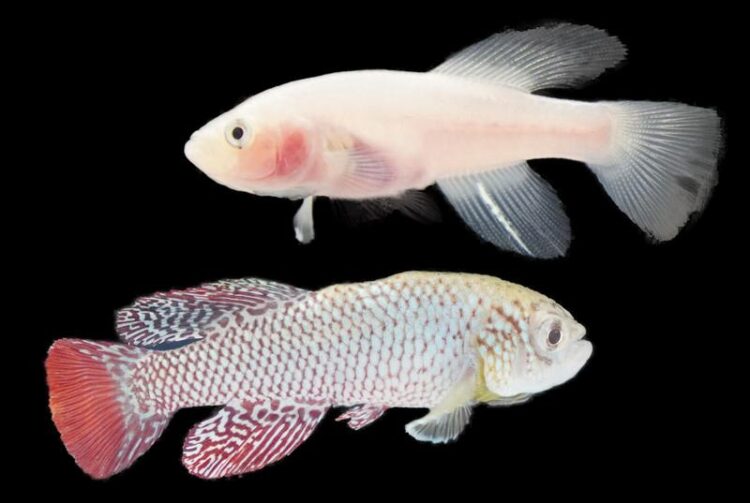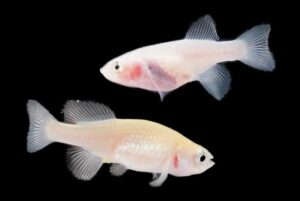Klara – A transparent fish for research on aging

By simultaneously inactivating three genes important for pigmentation in the turquoise killifish (Nothobranchius furzeri), a view into the fish’s interior is made possible. A male fish of the transparent klara line (top) compared to a wild-type male.
Photo: FLI / Kerstin Wagner
For in vivo studies of internal processes in an organism, body pigmentation is a considerable limitation. To circumvent this, various transparent fish models have already been generated, and are used in cancer research, among other things. In research on aging, however, these fish are rarely being used due to their relatively long lifespan of up to five years.
Researchers at the Leibniz Institute on Aging – Fritz Lipmann Institute (FLI) in Jena have now succeeded, with the help of the CRISPR/Cas9 technology, in generating a transparent killifish (N. furzeri) called “klara”, which, with a maximum lifespan of only one year, is ideal for in vivo studies of age-related processes.
The body pigmentation of an organism is caused by coloring substances and structures that are found in the cells of skin, hair, feathers, or scales, for example. This pigmentation considerably limits investigations of important processes within a living organism (in vivo). To provide a detailed view into the living body, scientists have used transparent model organisms.
Successfully generated transparent fish models, such as in zebrafish or medaka (Japanese rice fish), are already being used in cancer research. Lifespans of up to five years in the zebrafish or two years in medaka have largely limited the use of those species in aging research, as they render such investigations too lengthy and costly.
Researchers at the Leibniz Institute on Aging – Fritz Lipmann Institute (FLI) in Jena have now succeeded to generate a transparent killifish (Nothobranchius furzeri), called klara, using CRISPR/Cas9 technology. With a lifespan of only one year at most, klara facilitates in vivo studies of age-related processes. This means that new findings on the role and function of cells can be investigated much more comprehensively and in greater detail in the future. The current study has now been published in the renowned journal eLife.
Turquoise killifish – an animal model in research on aging

Photo: FLI / Kerstin Wagner
“In recent years, we have successfully established the turquoise killifish – which originally comes from East Africa and is known in German as the turquoise splendid ground carp, due to its beautiful, striking coloration – as a new model organism in aging research at our institute,” reports Prof. Christoph Englert, research group leader at the Leibniz Institute on Aging – Fritz Lipmann Institute (FLI) in Jena and Professor of Molecular Genetics at FSU Jena. “With a maximum lifespan of up to one year, this fish is until now the shortest-lived vertebrate that can be kept in the laboratory. Moreover, it is genetically similar to humans, ages extremely fast and shows typical signs of aging, which makes it very interesting for aging research,” adds Prof. Englert.
With the complete sequencing of the N. furzeri genome at the FLI, an important basis for future analyses has been made: the ability to specifically switch genes on and off and thereby learn about the influence of individual genes on aging or in relation to aging-related diseases.
Inactivation of pigmentation using CRISPR/Cas9
“In the turquoise killifish, there are three pigment cell types that are responsible for the fish’s very beautiful coloration,” explains Dr. Johannes Krug, a postdoc in the Englert Research Group. “The availability of the killifish genome sequence gave us the opportunity to investigate whether sequence-specific genome editing methods, such as CRISPR/Cas9, could be used to inactivate genes responsible for the body pigmentation to obtain a transparent fish for use in aging research. These studies were the main focus of my PhD thesis at the FLI.”
“Klara” – the transparent killifish
CRISPR/Cas9 is a molecular biology method that can be used to inactivate or modify genes in a sequence-specific manner, as if cutting them with a pair of scissors. By applying this method, the Jena researchers succeeded in deactivating the genes responsible for the fish’s pigmentation, thus generating a transparent killifish for the first time. The transparent fish line, which the researchers named klara (“klar” is the German word for “clear”), now gives researchers a clear view of the internal organs and their development inside a living animal.
The transparent fish line currently comprises about 200 animals at the FLI, both males and females, which can now be used in numerous aging research projects.
What role do senescent cells play in the aging process?
“Our transparent fish has great potential for aging research and opens a wide range of completely new applications. In my group, the new transparent fish line is already being used for in vivo studies of senescent cells,” reports Prof. Englert. Senescent cells are cells that no longer divide and that affect surrounding cells and tissue by constantly releasing pro-inflammatory factors. So far, little is known about the role and function of those cells.
It is known that in humans, but also in mice or killifish, the number of senescent cells increases with age, causing a kind of permanent inflammation in the body during the aging process. The targeted removal of senescent cells could therefore contribute to better health or even slow down the aging process. The research and development of substances known as senolytics, which can effectively remove senescent cells from the body, is therefore of great interest not only for the pharmaceutical and anti-aging industry, but also for aging research.
“With the klara line, we now can investigate the role of senescent cells in the living organism on a molecular level. By labeling them with fluorophores and then examining them under a fluorescence microscope, we can learn where they appear in the body and whether they are possibly clustered at certain locations, and what effects their removal has on the surrounding cells and tissues,” says Dr. Krug, highlighting the advantages of klara. This will lead to new insights regarding the role and function of this particular cell population during aging.
This project was made possible by funding from the Carl Zeiss Foundation in the context of the IMPULS consortium (project number P2019-01-006).
Publication
Generation of a transparent killifish line through multiplex CRISPR/Cas9-mediated gene inactivation. Krug J, Perner B, Albertz C, Mörl H, Hopfenmüller VL, Englert C. Elife. 2023, 12, e81549. https://doi.org/10.7554/eLife.81549
Contact
Dr. Kerstin Wagner
Press and Public Relations
Phone: 03641-656378, email: presse@leibniz-fli.de
Background information
The Leibniz Institute on Aging – Fritz Lipmann Institute (FLI) – upon its inauguration in 2004 – was the first German research organization dedicated to research on the process of aging. More than 350 employees from around 40 nations explore the molecular mechanisms underlying aging processes and age-associated diseases. For more information, please visit http://www.leibniz-fli.de
The Leibniz Association connects 97 independent research institutions that range in focus from natural, engineering and environmental sciences to economics, spatial and social sciences and the humanities. Leibniz Institutes address issues of social, economic and ecological relevance. They conduct basic and applied research, including in the interdisciplinary Leibniz Research Alliances, maintain scientific infrastructure, and provide research-based services. The Leibniz Association identifies focus areas for knowledge transfer, particularly with the Leibniz research museums. It advises and informs policymakers, science, industry and the general public. Leibniz institutions collaborate intensively with universities – including in the form of Leibniz ScienceCampi – as well as with industry and other partners at home and abroad. They are subject to a transparent, independent evaluation procedure. Because of their importance for the country as a whole, the Leibniz Association Institutes are funded jointly by Germany’s central and regional governments. The Leibniz Institutes employ around 20,500 people, including 11,500 researchers. The financial volume amounts to 2 billion euros. For more information: http://www.leibniz-gemeinschaft.de/en/.
Originalpublikation:
Generation of a transparent killifish line through multiplex CRISPR/Cas9-mediated gene inactivation. Krug J, Perner B, Albertz C, Mörl H, Hopfenmüller VL, Englert C. Elife. 2023, 12, e81549. https://doi.org/10.7554/eLife.81549
Media Contact
All latest news from the category: Life Sciences and Chemistry
Articles and reports from the Life Sciences and chemistry area deal with applied and basic research into modern biology, chemistry and human medicine.
Valuable information can be found on a range of life sciences fields including bacteriology, biochemistry, bionics, bioinformatics, biophysics, biotechnology, genetics, geobotany, human biology, marine biology, microbiology, molecular biology, cellular biology, zoology, bioinorganic chemistry, microchemistry and environmental chemistry.
Newest articles

First-of-its-kind study uses remote sensing to monitor plastic debris in rivers and lakes
Remote sensing creates a cost-effective solution to monitoring plastic pollution. A first-of-its-kind study from researchers at the University of Minnesota Twin Cities shows how remote sensing can help monitor and…

Laser-based artificial neuron mimics nerve cell functions at lightning speed
With a processing speed a billion times faster than nature, chip-based laser neuron could help advance AI tasks such as pattern recognition and sequence prediction. Researchers have developed a laser-based…

Optimising the processing of plastic waste
Just one look in the yellow bin reveals a colourful jumble of different types of plastic. However, the purer and more uniform plastic waste is, the easier it is to…



